Disclaimer: This article should not be construed as investment advice. The goal of the article is to help create an investment framework for crypto-assets and the author is not responsible for any losses arising out of investment in crypto or any other kind of investment.
Note: For the purpose of this article crypto-assets include cryptocurrencies, stablecoins, all kinds of crypto tokens, crypto derivative coins, and all crypto-related assets.
Previous article here: https://www.fintechna.com/articles/framework-for-investments-in-crypto-assets-part-23/
In the previous article in this series, we discussed adding crypto-assets to existing fiat denominated portfolios i.e. considering crypto-assets as an asset class. This article deals with creating standalone crypto-asset portfolios i.e. without any fiat asset.
When dealing with crypto-assets as an asset class, our portfolio is already denominated in fiat currency, say in dollars and the return and risk are measured in dollar terms. When creating a standalone crypto portfolio we have to choose the base currency of the portfolio. Now, this is important for multiple reasons. The risk-return relationships can be very different based on the currency in which the portfolio is denominated. Apart from fiat currencies such as dollar or yuan, portfolios can be denominated in terms of cryptocurrencies such as bitcoin or ether. The choice of the base currency of the portfolio can influence the risk-return relationships drastically. For example, volatility can be drastically lower in a bitcoin-denominated crypto portfolio.
But why would we ever want to create a cryptocurrency-denominated portfolio? The reason is that returns from various active-investing activities such as yield farming and staking are denominated in terms of cryptocurrencies. Transaction fees are also denominated in terms of cryptocurrencies. Denominating portfolios in terms of a cryptocurrency can make it easier to make asset allocation decisions and track performance for crypto portfolios that are actively managed.
So, let us divide our discussion of crypto-asset portfolio creation into two parts - Fiat Denominated crypto-asset Portfolios and Crypto Denominated crypto-asset Portfolios.
Fiat Denominated Crypto-asset Portfolios
This kind of crypto portfolio is suitable for investors who want to invest in crypto-assets passively for the long-term and not participate in active investing activities such as yield farming and staking.
The choice of the base currency for the portfolio is highly dependent on the domicile of the investor and accounting rules. Another step is choosing a suitable stablecoin and converting the fiat currency allocated for the portfolio to the stablecoin. Conversion of fiat to stablecoin makes managing liquidity and allocation of funds to different crypto-assets a little easier. Please note that although the stablecoin can be used for asset allocation, the portfolio remains denominated in the associated fiat currency. Let us focus on creating a USD-denominated portfolio for the purpose of this article.
The next step is choosing the crypto-assets with the most risk-adjusted return potential. We can use the approach we took in selecting crypto-assets for fiat portfolios.
I am using the same sample calculations I did for the previous article. I have calculated the average rolling 365-day return from 1st January 2019 to 23rd October 2021 for a basket of crypto assets with the potential to be added to the portfolio. Please note that the returns are calculated based on crypto-asset prices denominated in USD. The rationale behind choosing rolling return is to capture all return possibilities and the volatility of returns more effectively. Please refer to the previous article in this series for a more detailed explanation.
So, let us see the average of rolling 365-day returns
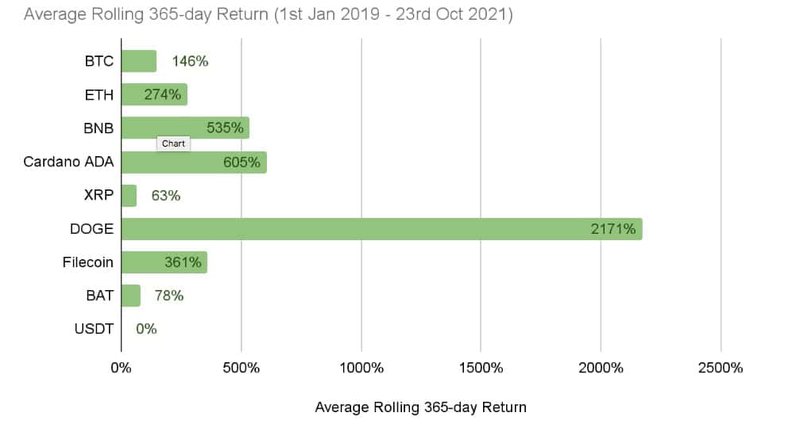
And the volatility of those returns
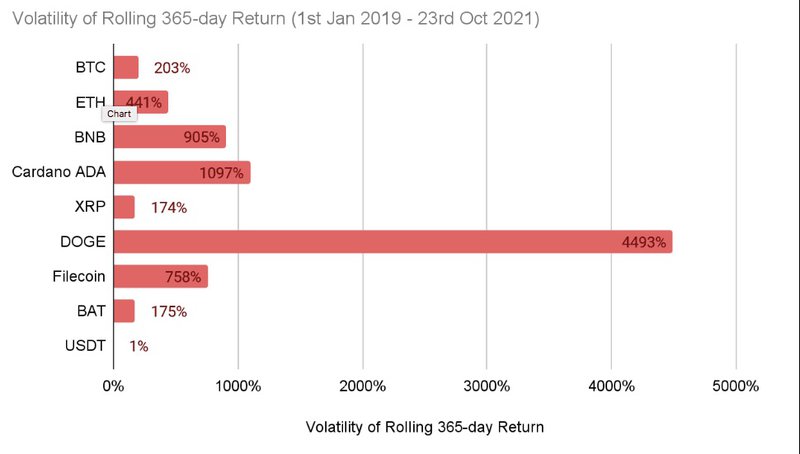
We can rank the crypto-assets by comparing returns and volatility using metrics such as Sharpe Ratio.
Till this point, the process is pretty similar to choosing crypto-assets as an asset class. We have to do a little more to create a portfolio. We can add crypto-assets to fiat portfolios as alternative investments, but how do we diversify our crypto portfolio?
For that, we need to understand the return correlation between different crypto-assets. I have created a correlation matrix for the rolling 365-day returns mentioned above. The correlation matrix is based on crypto-asset returns in USD prices.
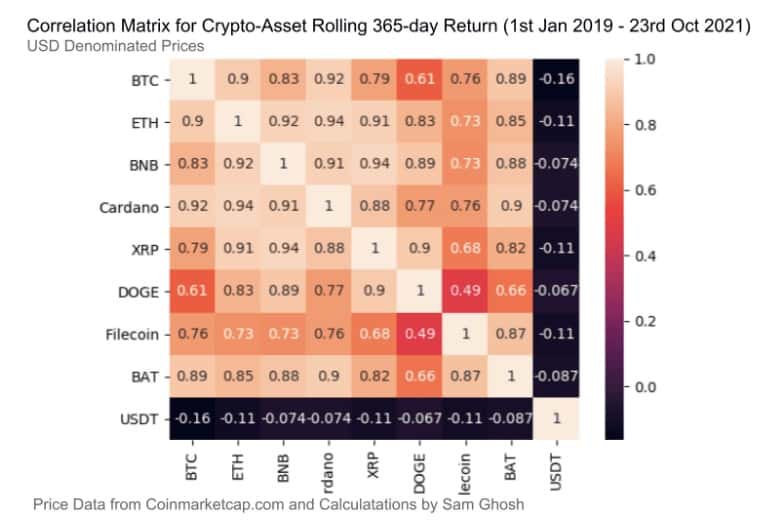
Now, let us see how we can use the correlation matrix. You may find some crypto investment products which add Ether (ETH) to Bitcoin (BTC) for diversification. We can see that adding ETH to BTC cannot really create any diversification benefit as these crypto-assets are highly correlated.
So, what crypto-assets can be added to BTC for diversification? One choice is stablecoins pegged to USD as we can see USDT is negatively correlated with BTC. The problem is that as the portfolio is denominated in USD, adding USDT (which is pegged to USD) to the portfolio would mean lowering return prospects for the portfolio. The next option is Dogecoin which is comparatively less correlated with BTC and adds very high return prospects to the portfolio but also increases the volatility of the portfolio.
Anyways, the point is that a correlation matrix can help create a diversified crypto portfolio.
Now, let us talk about crypto-denominated crypto portfolios.
Crypto Denominated Crypto-asset Portfolios
A crypto denominated crypto-asset portfolio is suitable for investors who are more experienced and skilled with the crypto ecosystem. These investors are adept at yield farming, staking, swapping, etc., and employ their crypto-assets in the DeFi ecosystem to grow their assets. Returns from these activities are generally denominated in cryptocurrencies. These processes may also involve transaction costs denominated in cryptocurrencies. So, denominating the portfolio in terms of cryptocurrencies can be operationally more efficient.
The process of creating the portfolio starts with selecting the base currency for the portfolio. The process is a little more complex than fiat denominated portfolios. We need to choose a base currency with a moderately high long-term growth prospect in terms of fiat currencies but at the same time stable in terms of economics and technology. The base currency also needs to be highly liquid with well-diversified ownership. The currency preferably should also have a low transaction cost.
Now, the second step is converting the crypto-asset prices in terms of the chosen base currency. We can now calculate the returns and volatility of returns with the new cryptocurrency denominated prices.
I did some sample calculations with Bitcoin (BTC) as the base currency.
Average rolling 365-day returns from various crypto-assets in terms of BTC.
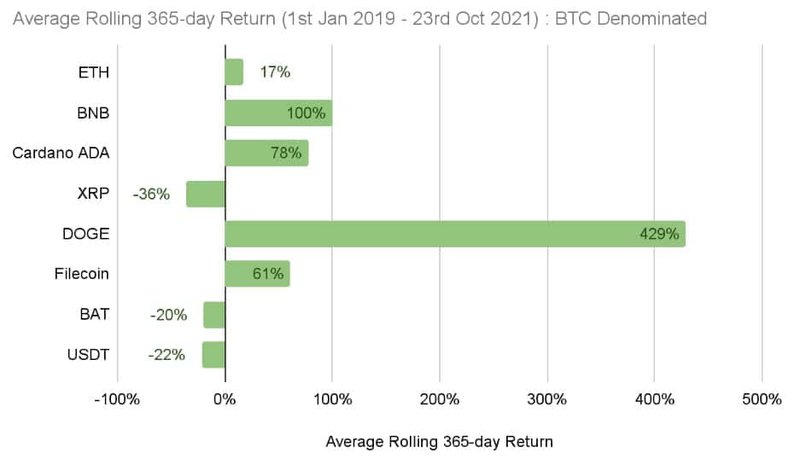
The volatility of rolling 365-day returns.
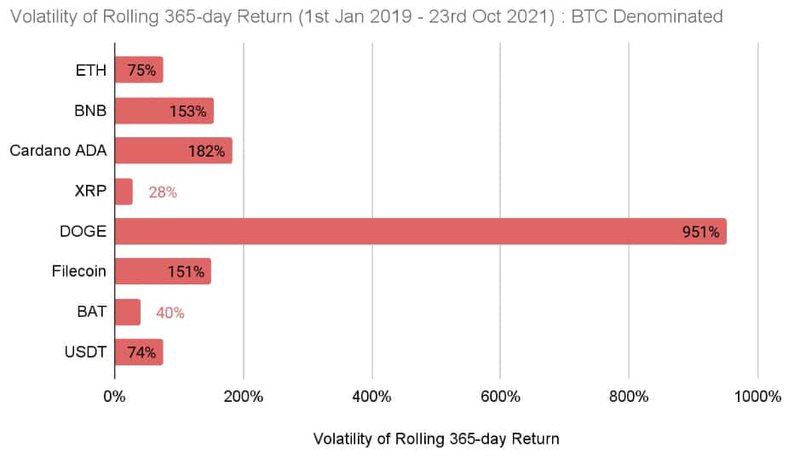
Now, we can calculate risk-adjusted returns using the BTC denominated prices and choose the assets with the highest risk-adjusted return.
For creating a balanced portfolio, we need diversification. So, I created a correlation matrix based on the BTC denominated returns. For the sake of this article, say let us choose BNB (Binance Coin) for our portfolio.
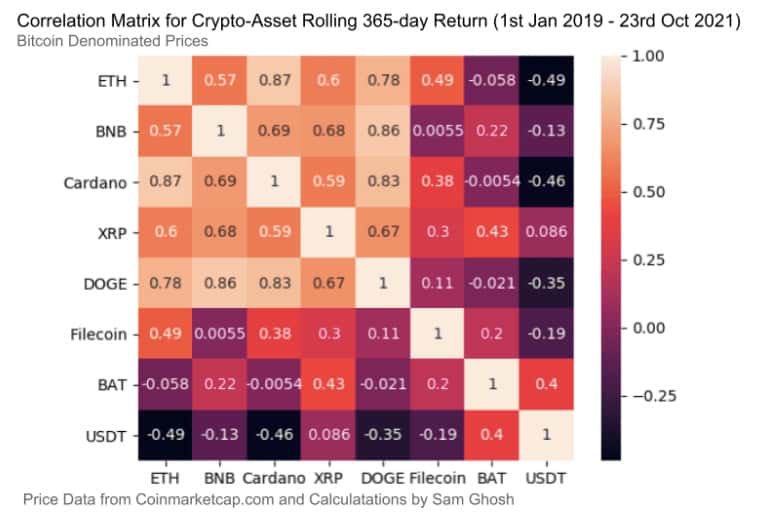
The correlation matrix can be used to pick assets that effectively diversify BNB. USDT may stand out with a negative correlation with BNB but it also has a negative average BTC denominated return. So, we cannot select USDT. Dogecoin has remarkable returns in terms of BTC as well but it is also highly correlated with BNB. So, adding Dogecoin to the portfolio may increase the growth prospects but is likely to make the portfolio more volatile. The point is that the decision-making does not end with the correlation matrix and requires the investor to make judgment calls based on portfolio goals.
Another aspect of a crypto-denominated crypto-asset portfolio is choosing assets with multiple sources of return i.e. assets that can be employed for yield farming and staking on multiple DeFi platforms. Remember that the primary reason for denominating the crypto-asset portfolio in terms of a cryptocurrency is to make better active investment decisions.
So, the investor needs to consider how many DeFi platforms accept the crypto-assets for liquidity pools or for staking in a PoS consensus and what kind of incentives the investor may receive locking the crypto-assets in the liquidity pools or for staking. This makes portfolio creation a lot more complex but can also increase the return prospects dramatically.
So, let us conclude this series here. I have written the articles to structure my own thinking about investing in crypto-assets and I will be glad if people find them useful. Let me reiterate that this series of articles is not a comprehensive guide for investment in crypto-assets and investors should do their own research and analysis before investing in crypto-assets.












